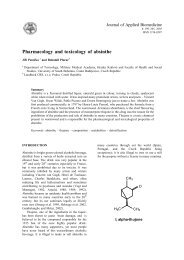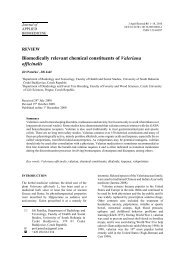Advances in biosensors: principle, architecture and applications
Advances in biosensors: principle, architecture and applications
Advances in biosensors: principle, architecture and applications
Create successful ePaper yourself
Turn your PDF publications into a flip-book with our unique Google optimized e-Paper software.
1<br />
2<br />
3<br />
4<br />
5<br />
6<br />
7<br />
8<br />
9<br />
10<br />
11<br />
12<br />
13<br />
14<br />
Fig. 3.0. Methods of biosens<strong>in</strong>g with various biological signal mechanism: (a) antibody/antigen; (b)<br />
enzyme catalyze; (c) nucleic acid; (d) cell-based; (e) biomimetic.<br />
Enzyme based sensor<br />
Enzyme based biosensor are the earliest biosensor among all the other biosensor, these<br />
biosensor is first <strong>in</strong>troduced by Clark <strong>and</strong> Lyons <strong>in</strong> 1962 an amperometric enzyme electrode<br />
for glucose sensor which use ‘soluble’ enzyme electrode (Shantilatha et al. 2003). S<strong>in</strong>ce the<br />
first biosensor, enzyme based biosensor has face a massive growth <strong>in</strong> usage for various<br />
application till present. Enzymes are very efficient biocatalysts, which have the ability to<br />
specifically recognize their substrates <strong>and</strong> to catalyze their transformation. These unique<br />
properties make the enzymes powerful tools to develop analytical devices (Leca-Bouvier <strong>and</strong><br />
Blum 2010). Enzyme-based <strong>biosensors</strong> associate <strong>in</strong>timately a biocatalyst-conta<strong>in</strong><strong>in</strong>g sens<strong>in</strong>g<br />
layer with a transducer. Enzyme based biosensor work<strong>in</strong>g pr<strong>in</strong>cipal is based on catalytic<br />
5





